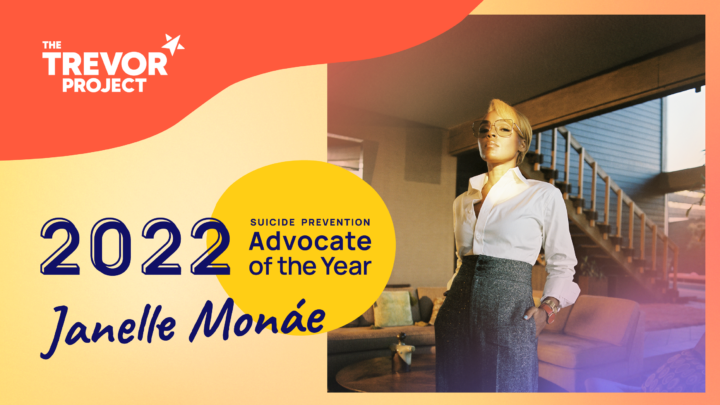Youth's Lives Every Day
- 41% of LGBTQ young people seriously considered attempting suicide in the past year — and young people who are transgender, nonbinary, and/or people of color reported higher rates than their peers.
- LGBTQ young people who were physically threatened or harmed in the past year due to either their sexual orientation or gender identity reported triple the rate of attempting suicide in the past year compared to those who were not.
- LGBTQ young people who had access to affirming homes, schools, community events, and online spaces reported lower rates of attempting suicide.
- Transgender and nonbinary young people reported lower rates of attempting suicide when all of the people they live with respected their pronouns and/or they had access to a gender-neutral bathroom at school.
May 1, 2023 — The Trevor Project, the leading suicide prevention organization for LGBTQ young people, released the findings of its 2023 U.S. National Survey on the Mental Health of LGBTQ Young People today, representing the experiences of more than 28,000 LGBTQ young people ages 13 to 24 across the country. The survey finds that LGBTQ young people continue to report significantly high rates of mental health challenges and suicide risk and that experiences of anti-LGBTQ stigma and victimization are associated with these disparities. However, the survey also underscores the protective nature of affirming homes and schools, and how LGBTQ young people would envision a more accepting world.
41% of respondents seriously considered attempting suicide in the past year, including half of transgender and nonbinary young people and nearly 3 in 10 cisgender young people (29%). A large majority of LGBTQ young people also reported recent symptoms of anxiety (67%) and depression (54%), yet 56% of young people who wanted mental health care in the past year were not able to get it. The top four barriers to care reported by young people were the same as last year: fear about discussing mental health, concerns with parental permission, fear of not being taken seriously, and lack of affordability.
“The Trevor Project’s fifth annual national U.S. survey adds to a growing body of literature detailing the harmful mental health impacts of anti-LGBTQ victimization on young people and the life-saving potential of support and acceptance,” said Dr. Ronita Nath (she/her pronouns), Vice President of Research for The Trevor Project. “The CDC’s latest data emphasized that queer students face disproportionate rates of poor mental health and suicide risk — and our research takes it a step further by illuminating disparities among LGBTQ young people across age, gender identity, race/ethnicity, region, and expansive sexual orientations. As the existence of LGBTQ young people continues to be unfairly put up for debate, it’s critical to consistently underscore that these challenges are not inherent to LGBTQ identity, but rather stem from stigma, discrimination, and violence.”
The survey consistently finds that LGBTQ young people who experienced victimization on the basis of their sexual orientation or gender identity reported higher rates of attempting suicide. For example, 24% of LGBTQ young people reported that they were physically threatened or harmed in the past year due to either their sexual orientation or gender identity, and those who were reported triple the rate of attempting suicide in the past year compared to those who were not. Further, 60% of LGBTQ young people reported that they felt discriminated against in the past year and 15% reported being threatened with or subjected to conversion therapy. In both cases, LGBTQ young people who experienced this type of victimization attempted suicide at more than double the rate of those who have not.
However, this research once again emphasizes the importance of safe spaces and social support in suicide prevention. LGBTQ young people who had access to affirming homes, schools, community events, and online spaces reported lower rates of attempting suicide compared to those who did not. And transgender and nonbinary young people reported lower rates of attempting suicide when all of the people they live with respected their pronouns and/or they had access to a gender-neutral bathroom at school. Tragically, just 52% of transgender and nonbinary young people reported having access to a gender-affirming school and only 35% had an affirming home.
“Among transgender and nonbinary young people, half seriously considered suicide, and one in five attempted suicide in the past year. This is a public health crisis — and it’s preventable,” said Kasey Suffredini (he/him pronouns), Vice President of Advocacy & Government Affairs for The Trevor Project. “Our government must work from the top down to curb risk factors like violence and discrimination and increase access to essential health care, safe schools, and support systems. Yet, far too many lawmakers at the state level are working overtime to push a dangerous political agenda that will jeopardize young lives. We understand that some of these issues can seem complicated for people who’ve never met a transgender person, but the impact of victimization on our young people is clear and dire.”
LGBTQ young people who held more marginalized identities reported greater suicide risk compared to their peers. Nearly 1 in 5 transgender and nonbinary young people (18%) attempted suicide in the past year compared to nearly 1 in 10 cisgender lesbian, gay, bisexual, queer, and questioning young people (8%). The rate of attempting suicide among LGBTQ young people of color who are Native/Indigenous (22%), Middle Eastern/Northern African (18%), multiracial (17%), Black (16%), and Latinx (15%), was higher than that of Asian American/Pacific Islander (10%) and white (11%) LGBTQ young people. Additionally, young people who identified as pansexual attempted suicide at a significantly higher rate (18%) than those who identified as lesbian (13%), gay (11%), and bisexual (12%). And across the four major regions of the country, LGBTQ young people from the South and Midwest predominantly reported higher rates of suicide risk and anti-LGBTQ victimization compared to those from the Northeast and West.
Additional findings from the survey include:
A record number of anti-LGBTQ policies have been introduced and implemented in the last year — and they’re negatively impacting LGBTQ young people’s mental health.
- Nearly 1 in 3 LGBTQ young people said their mental health was poor most of the time or always due to anti-LGBTQ policies and legislation.
- Nearly 2 in 3 LGBTQ young people said that hearing about potential state or local laws banning people from discussing LGBTQ people at school made their mental health a lot worse.
- Conversely, 79% of LGBTQ young people said hearing about potential state and local laws trying to ban conversion therapy made them feel a little or a lot better.
As many anti-LGBTQ bills seek to censor LGBTQ content in schools and restrict the ability of parents to support their transgender and nonbinary kids, these data underscore the importance of affirming homes and schools.
- 38% of LGBTQ young people found their home to be LGBTQ-affirming and 54% found their school to be affirming. Among transgender and nonbinary young people, 35% found their home to be gender-affirming and a little more than half (52%) found their school to be affirming. Across the board, young people who had access to affirming homes and schools reported much lower rates of attempting suicide in the past year.
- Alarmingly, many LGBTQ young people enrolled in school reported having a range of negative experiences, including being verbally harassed because people thought they were LGBTQ (53%); not being allowed to dress in the way that fits their gender identity or expression (32%); being disciplined for fighting back against bullies (25%); and experiencing unwanted sexual contact because people thought they were LGBTQ (20%).
- Additionally, only 37% of transgender and nonbinary young people reported having a gender-neutral bathroom at their school, and those who had access reported lower rates (15%) of attempting suicide in the past year compared to those who did not (21%).
The survey asked LGBTQ young people to describe what a world would look like where all LGBTQ people are accepted.
- Common responses included: people are able to express themselves and be who they want to be; people mind their business; people have better mental health; gender-neutral bathrooms; no one would have to worry about coming out; and no more anti-LGBTQ laws.
- In terms of emotions, most LGBTQ young people said that the world would feel better, happy, peaceful, beautiful, safe, and comfortable.
If you or someone you know needs help or support, The Trevor Project’s trained crisis counselors are available 24/7 at 1-866-488-7386, via chat at TheTrevorProject.org/Get-Help, or by texting START to 678678.
Methodology
The content and methodology for The Trevor Project’s 2023 U.S. National Survey on the Mental Health of LGBTQ Young People were approved by an independent Institutional Review Board.
This quantitative cross-sectional survey was conducted using an online platform between September 1 and December 12, 2022. A sample of 28,524 LGBTQ young people ages 13 to 24 who resided in the United States was recruited via targeted ads on social media. No recruitment was conducted via The Trevor Project’s website or social media channels. Respondents were defined as being LGBTQ if they identified with a sexual orientation other than straight/heterosexual, a gender identity other than cisgender, or both. This report uses “transgender and nonbinary” as an umbrella term to encompass a wide variety of gender identities held by non-cisgender young people. In order to ensure the representativeness of the sample, targeted recruitment was conducted to ensure adequate sample sizes with respect to geography, gender identity, and race/ethnicity.
For media inquiries, please contact: Press@TheTrevorProject.org
For research-related inquiries, please contact: Research@TheTrevorProject.org

